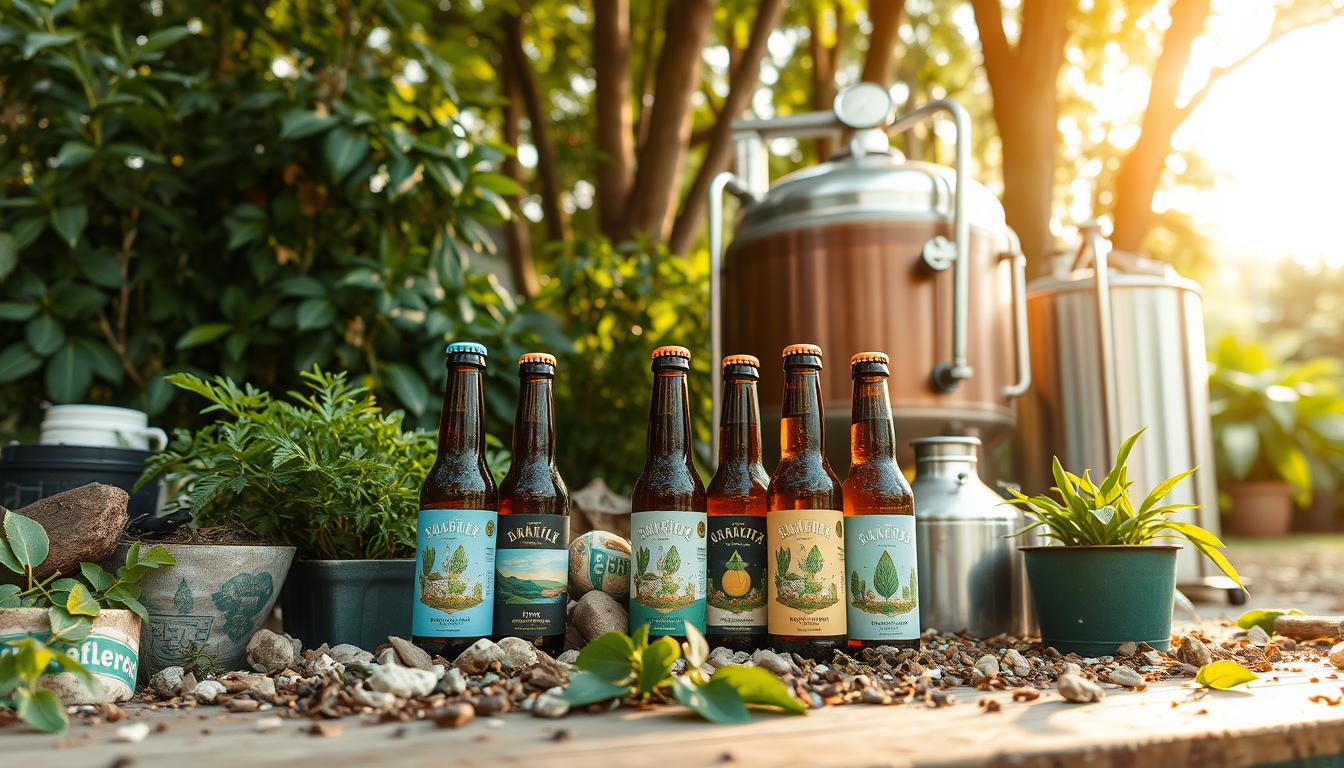Craft breweries are embracing sustainability like never before. They’re making positive changes to help our planet. Let’s explore how these eco-friendly beers are making a difference.
Sustainable craft beer is reshaping the industry. It’s not just a trend, but a movement. Green brewing practices are becoming common in many U.S. craft breweries.
Breweries are using innovative methods to reduce their environmental impact. They focus on water conservation and renewable energy. These practices help create delicious beers while protecting the environment.
Some breweries are leading the way in sustainability. Anderson Valley Brewing Company uses 40% solar power. New Belgium Brewing Company diverted 99% of its waste from landfills in 2016.
This shift towards sustainability is exciting for beer lovers. It ensures we can enjoy great craft beer for years to come. Let’s celebrate eco-friendly brews and the breweries championing sustainable practices.
The Rise of Sustainable Craft Beer
Craft beer lovers are seeing a brewing revolution. Breweries are adopting eco-friendly practices to meet consumer demands. This shift shows a deeper grasp of needed environmental impact cuts.
Environmental Awareness in Brewing
Breweries are working to shrink their ecological footprint. Many now use energy-efficient gear and renewable power sources. Alice Springs Brewing Co’s 50kW solar system meets 80% of their power needs.
Water saving is also key. Some breweries use new methods to cut water use during brewing.
Eco-Friendly Consumer Demand
Buyers are pushing for change. A 2018 study found U.S. beer drinkers will pay more for sustainable brews. They prefer brands open about their green practices.
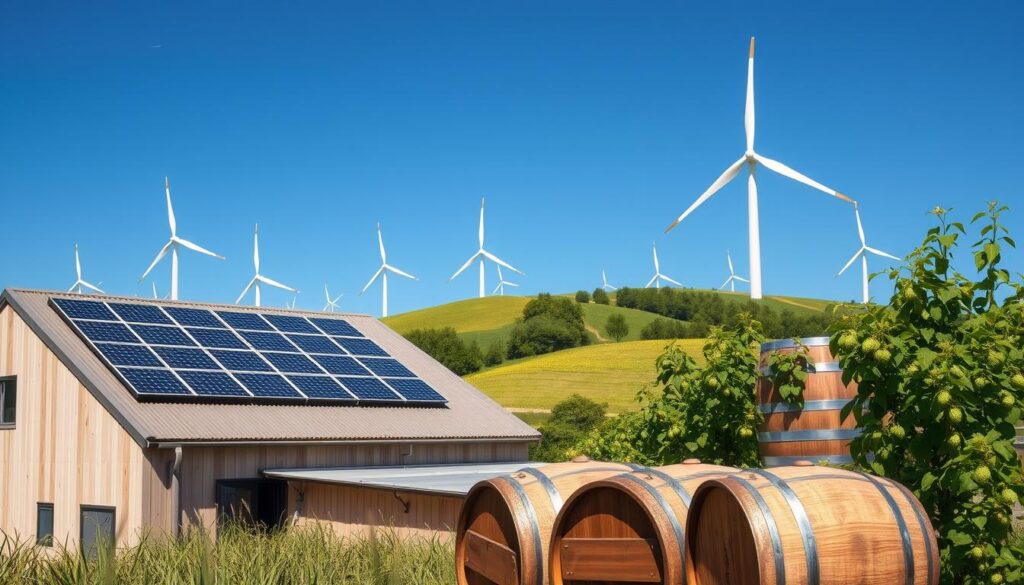
Defining Sustainability in Craft Beer
Green craft beer making covers various practices. Organic ingredients are trending, with Peak Organic Brewing Co. known for organic IPAs. Water saving is vital in brewing.
It takes 3-7 barrels of water to make one barrel of beer. Some breweries, like Village Brewery in Calgary, even use purified wastewater.
| Sustainable Practice | Example Brewery | Impact |
|---|---|---|
| Organic Ingredients | Eel River Brewing Co. | First U.S. brewery with USDA organic certification |
| Local Sourcing | Mountain Tap Brewery | Supports local agriculture, reduces carbon footprint |
| Water Conservation | Alice Springs Brewing Co | Recaptures wastewater for irrigation and cleaning |
Organic Brewing: A Cornerstone of Sustainability

Craft beer production is evolving with organic brewing at the forefront. Breweries are embracing sustainable practices and using organic ingredients. This approach supports eco-friendly agriculture and creates unique flavors for beer lovers.
Chemical-free brewing is crucial to this movement. Breweries source ingredients from organic farms, reducing harmful chemicals. This benefits the environment and improves beer quality. Some breweries even grow their own organic ingredients.
The impact of organic brewing goes beyond the beer itself. California, with its many breweries, is pushing for reduced carbon footprints. Organic practices are leading the way in sustainability efforts.
- 80% reduction in demolition debris through reuse
- 60% less energy used in the boiling process
- 50% more water-efficient brewing systems
These stats show the real benefits of sustainable brewing. Eco-conscious consumers are driving demand for organic craft beers. Green brewing is the future, with organic ingredients leading the charge.
Locally Sourced Ingredients: Supporting Eco-Friendly Production
Local sourcing revolutionizes sustainable craft beer production. It reduces food miles and supports nearby communities. Breweries using local ingredients create fresher, higher-quality brews while cutting transportation emissions.
Benefits of Using Local Ingredients
Local sourcing offers numerous advantages for craft breweries:
- Reduced carbon footprint through decreased transportation
- Support for local economies and farmers
- Fresher ingredients leading to better-tasting beer
- Unique regional flavors that set brews apart
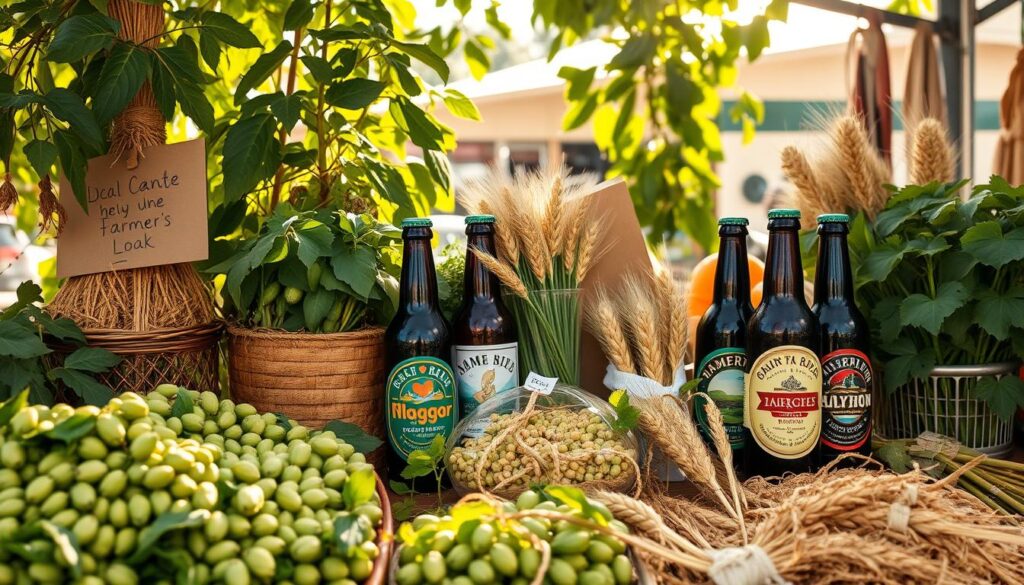
Breweries Championing Local Sourcing
Many craft breweries lead in local sourcing. Sierra Nevada partners with nearby hop farms. New Belgium collaborates with local barley growers.
These partnerships benefit the environment and strengthen community ties. They showcase the industry’s commitment to sustainability and local support.
Impact on Beer Flavor and Quality
Local ingredients enhance beer flavor and quality. Fresher hops and grains create more vibrant tastes. Unique local varieties add distinctive regional characteristics.
This focus on quality helps craft breweries stand out. It allows them to offer exceptional flavors in a competitive market.
| Local Sourcing Impact | Benefits |
|---|---|
| Environmental | Reduced food miles, lower emissions |
| Economic | Community support, local job creation |
| Quality | Fresher ingredients, unique flavors |
Local sourcing in craft brewing promotes sustainability and community support. It proves that eco-friendly practices and exceptional beer go hand in hand.
Water Conservation in Craft Beer Production
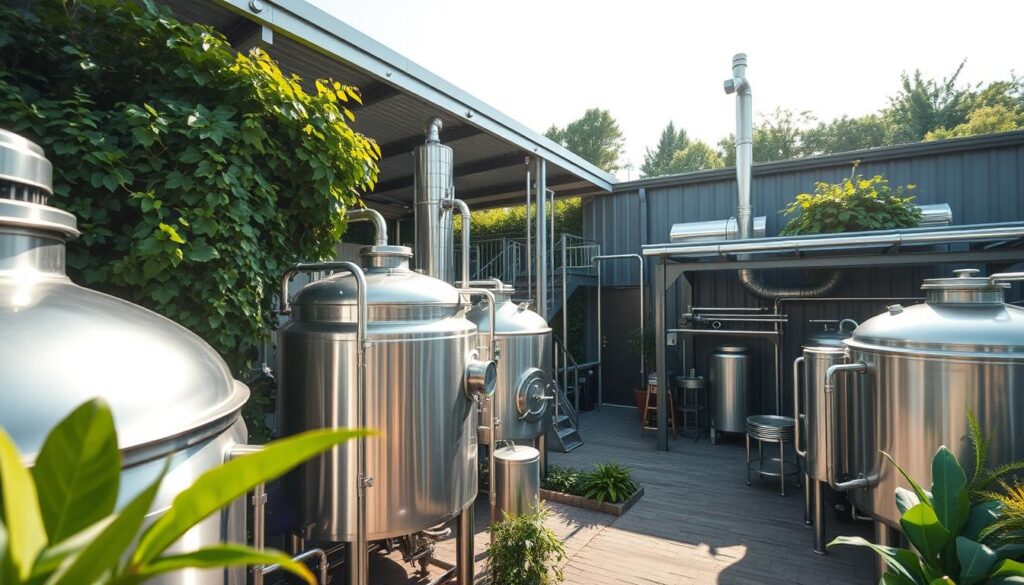
Water efficiency is crucial in the craft beer industry. Brewing one gallon of beer typically needs seven gallons of water. Many breweries now use innovative ways to save water.
Sierra Nevada Brewing Co. leads with their water recycling system. New Belgium Brewing Company uses efficient techniques and advanced wastewater treatment. These methods save water and reduce costs.
Drought-resistant brewing is becoming popular among craft breweries. Seismic Brewing in Santa Rosa uses less than 3 gallons of water per gallon of beer. The Ronin Fermentation Project achieves a 2.8:1 ratio through on-site wastewater treatment.
- Industry average water-use ratio: 7:1
- Sustainable water-use ratio: Below 4:1
- Seismic Brewing’s water-use ratio: Below 3:1
The Brewers Association suggests improving processes and monitoring as first steps. These practices can greatly benefit breweries making over 100 barrels yearly. They can save money and help the environment.
Renewable Energy in Brewing: Powering Sustainable Craft Beer
Craft breweries are leading the charge in sustainable practices. Many are turning to renewable energy sources like solar and wind. This shift is making the industry more eco-friendly and cost-effective.
Solar Power Initiatives in Craft Breweries
Over 140 American breweries now use solar power. Sierra Nevada Brewing stands out, generating about 2½ MW of solar energy. This powers 20% of their Chico, California brewery and 7% of their North Carolina location.
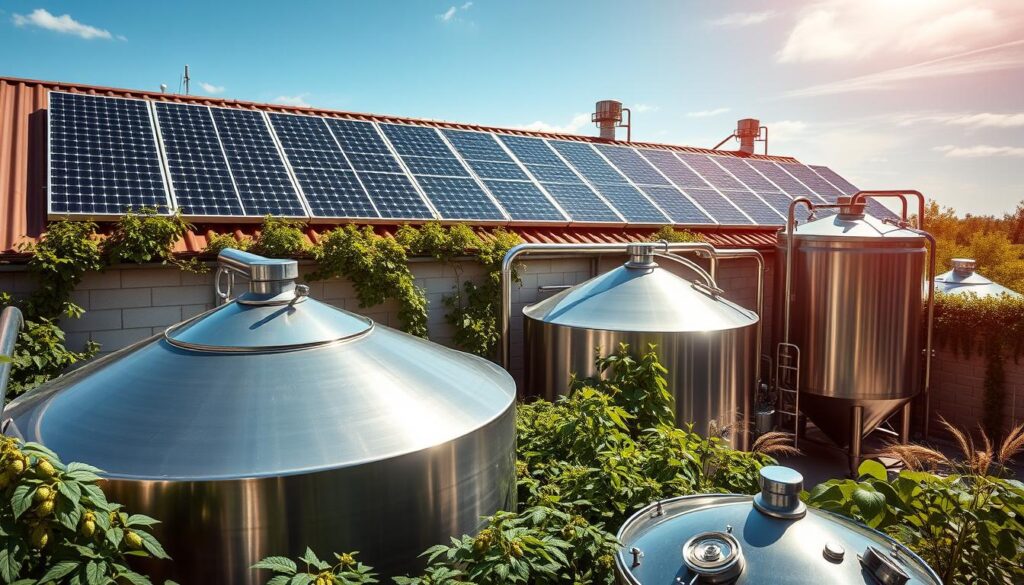
New Belgium Brewing Company has nearly 300 kilowatts of on-site solar power. Maui Brewing Company aims to produce 100% of its electricity needs with solar power. They’re pioneering a “grid-independent” system for brewing.
Wind Energy Adoption
Wind energy offers another renewable option for breweries. Anheuser-Busch plans to power Budweiser’s brewing process through wind energy. This could reduce their carbon footprint by 30%, equal to removing 48,000 cars from the road yearly.
Innovative Energy Solutions
Breweries are finding new ways to become more energy-efficient. Some use micro-turbine systems to generate steam and electricity. Others use Cambrian’s EcoVolt wastewater system to produce clean heat and electricity.
The push for renewable energy in brewing is environmentally responsible and economically smart. Tax incentives and improving technology make solar-powered brewing viable for craft breweries of all sizes.
Reusable Packaging: Reducing Waste in the Craft Beer Industry
Craft breweries are embracing sustainable packaging to cut down on waste. They’re shifting towards refillable growlers and reusable kegs. This marks a significant step in eco-friendly practices.
Innovative solutions like refillable growlers are being introduced for takeaway beer. These containers have a much smaller carbon footprint than single-use options. Some breweries are exploring refillable bottle systems that can be used up to 25 times.

Reusable kegs are gaining popularity for larger gatherings. They’re an environmentally friendly alternative to cases of bottles or cans. This shift reduces waste and enhances the product experience for consumers.
Here are some exciting statistics:
- Up to 50 breweries will receive funding to establish reusable packaging asset pools
- Managing and washing reusables can cost just two-thirds of single-use packaging
- A new interoperable, reusable “growler” will replace standard brown PET bottles in New Zealand
These initiatives show the potential for a circular economy in craft beer. The industry is taking proactive steps towards sustainability. It’s an encouraging trend for the environment.
| Packaging Type | Environmental Impact | Consumer Appeal |
|---|---|---|
| Refillable Growlers | Low carbon footprint | High – Fresh beer experience |
| Reusable Kegs | Significantly reduces waste | High – Perfect for gatherings |
| Single-Use Bottles | High waste generation | Low – Environmental concerns |
Sustainable packaging solutions are reducing environmental impact in craft breweries. They’re also meeting growing consumer demand for eco-friendly options. It’s a positive change for both the industry and beer lovers.
Carbon Footprint Reduction Strategies for Breweries
Craft breweries are making big moves to cut their carbon footprint. The beer industry faces serious eco-challenges. A single pint of beer can have a carbon footprint of up to 900g CO2e.
This is about 14% of the daily average carbon footprint from meals for a US citizen. Let’s explore how breweries are tackling this issue.
CO2 Reclamation Systems
CO2 reclamation is a game-changer in brewing. These systems capture and clean CO2 produced during fermentation. They then reuse it in the brewing process.
This smart move cuts down on waste and the need to buy CO2. It leads to significant carbon footprint reduction.
Efficient Brewing Processes
Breweries are getting creative with efficient brewing techniques. Some use systems that cut boiling time, saving energy and lowering emissions.
Others focus on water use. The brewing process can use 3-7 barrels of water for one barrel of beer. Closed-loop systems allow breweries to reuse treated wastewater, saving this precious resource.
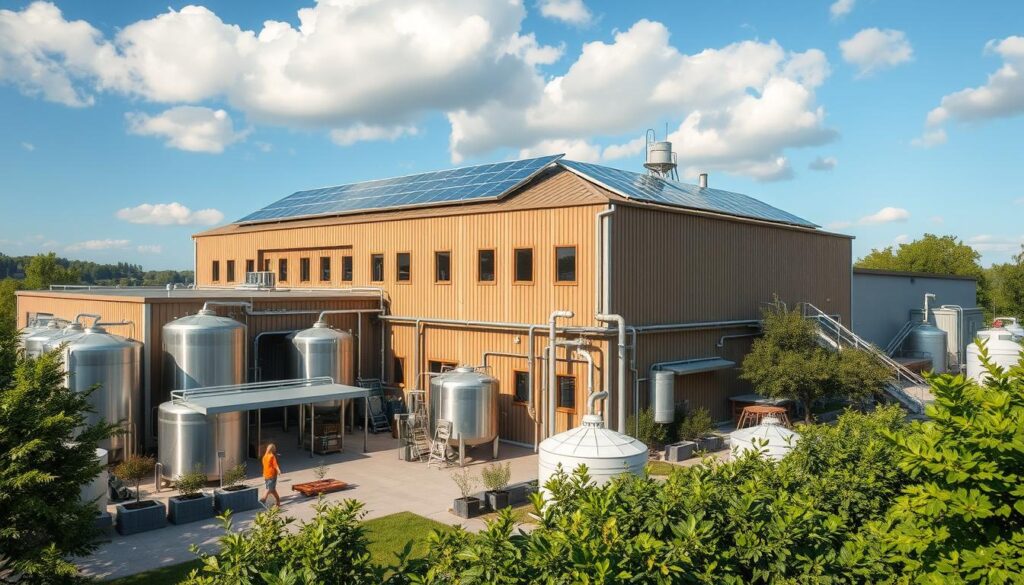
Sustainable Transportation Methods
Transportation makes up about 20% of a pint’s carbon footprint. Some breweries are thinking outside the box to address this issue.
BrewVo creates a highly concentrated beer that’s 1/6th the weight of traditional beer. This dramatically cuts transport-related emissions. Other breweries explore local delivery options, like using bicycles for short-distance keg deliveries.
| Strategy | Impact |
|---|---|
| CO2 Reclamation | Reduces waste and need for purchased CO2 |
| Efficient Brewing | Lowers energy use and water consumption |
| Sustainable Transport | Cuts emissions from product distribution |
These strategies show how breweries are leading the charge in sustainable practices. By adopting these methods, craft breweries are making great brews and taking steps towards a greener future.
Community Involvement and Ethical Business Practices
Sustainable craft breweries are expanding their environmental commitment beyond brewing. They’re engaging in community outreach and adopting ethical business practices. Great Lakes Brewing’s “Brewing Good” project involves volunteering with non-profits and donating to clean water initiatives.
Many breweries are boosting their social responsibility efforts. They support local environmental causes and organize community clean-ups. They also prioritize ethical ingredient sourcing, strengthening connections with their communities.
Breweries are reducing carbon emissions by using renewable energy sources. They’re conserving water through rainwater harvesting and closed-loop systems. Some have significantly cut water usage, showing strong commitment to sustainability.
Sustainability scores reveal leading breweries in environmental stewardship. Little Valley Brewery’s Radical Roots pale ale scores 85 out of 100. Hepworth beer and Toast Ale follow closely with 83.
These high scores reflect a focus on environmental care and ethical practices. They embody the spirit of community-focused, responsible brewing.

